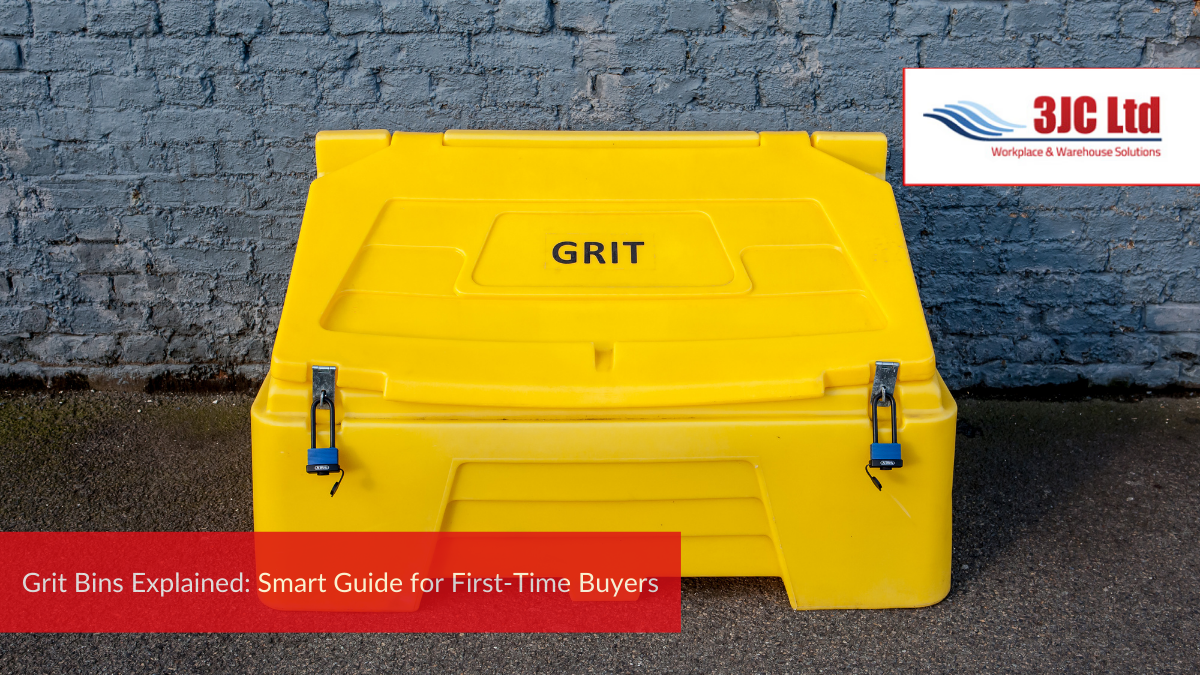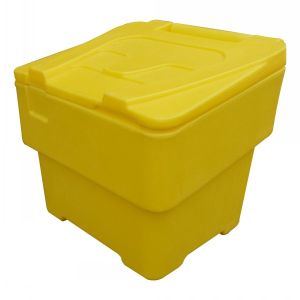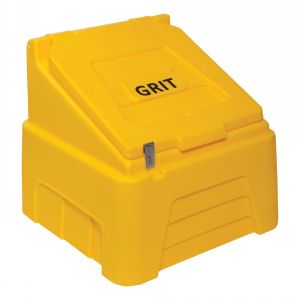
UK grit bins represent essential winter safety equipment available across multiple specifications and sizes. The market offers options from basic 60-litre units at £81 through to 200-litre units suitable for varied applications from domestic use to commercial requirements.
The standard construction features impact-resistant plastic materials fitted with robust weather seals and practical handling features. Several manufacturers now produce units from recycled materials, addressing environmental considerations without compromising durability.
This guide examines key aspects of grit bin selection, detailing crucial factors from size requirements to placement strategies. Readers will discover specific features, maintenance protocols, and practical considerations essential for informed purchasing decisions.
Planning Your Grit Bin Investment
Successful winter safety equipment selection demands precise planning. The required bin capacity correlates directly with the protected area size. Large commercial spaces and main roads demand 400-litre units, while small business premises and residential areas function effectively with 200-litre capacity bins.
Assessing your winter safety needs
Site evaluation requires analysis of path gradients, junction proximity, and property density within the service area. Critical assessment points focus on high-traffic zones, particularly walkways and entrance points where ice formation presents significant risks.
Budgeting for complete winter preparation
Small Salt & Grit Bin
Capacity: 60 Litre / 70 KG
Very durable – can be left out all year with no fear of cracking or discolouration.
Hinged lid protects the salt from the elements.
Lightweight bins are easy to move and put away during the summer months.
Heavy Duty Salt & Grit Bins
Capacity: 200 Litre/250KG
External dimensions: 720mm Long x 750mm Wide x 710mm High.
Very durable – can be left out all year with no fear of cracking.
Hinged lid protects the salt from the elements.
High Visibility Yellow colour.
Hasp and staple fitted as standard (for padlock)
Embossed with GRIT Graphic as standard.
Comparing different Grit Bin supplier options
Product specification analysis proves crucial during supplier selection. Premium manufacturers utilise UV-stabilised polyethene construction, ensuring structural rigidity. Essential features encompass:
Quality units incorporate through-rod hinge mechanisms paired with pad-lockable lids, providing robust security measures. Environmental specifications extend to recycled material construction options.
Product verification should confirm weather-seal quality and ergonomic handle specifications before purchase completion.
Smart Features of Modern Salt Bins
Salt bin technology presents significant advancements in durability and functionality. These storage units excel in security features while addressing crucial environmental considerations through specialised design elements.
Advanced locking mechanisms
Security specifications stand paramount in current grit bin engineering. Standard units feature robust hasp and staple mechanisms compatible with conventional padlocks. Select models offer integrated key locks, establishing dual-layer security protocols against unauthorised access and winter supply protection. These security measures prove essential in preventing salt theft and material contamination.
Weather-resistant technologies
Current grit bin specifications showcase superior weather protection capabilities. The units utilise high-grade, UV-stabilised polyethene construction, delivering excellent resistance to impact damage, corrosion, and environmental degradation. Key moisture control elements include:
- Salt-resistant rubber seals
- Reinforced clasps
- Water ingress protection systems
The structural design incorporates reinforced components and durable hinges, enabling 270-degree lid movement whilst preserving contents against precipitation.
Environmental impact considerations
Salt storage environmental implications warrant careful attention. Scientific evidence highlights significant risks from exposed salt storage to local water tables and plant life. Modern manufacturing addresses these concerns through:
Purpose-built units from recycled materials reduce ecological impact. Specialised designs prevent salt penetration into roadside vegetation and groundwater systems. These protective measures safeguard local ecosystems and preserve biodiversity.
Recent models incorporate advanced moisture management systems, maintaining optimal storage conditions while minimising environmental effects. These design elements establish an effective balance between winter safety requirements and ecological responsibility.
Installation and Placement Strategy
Grit bin placement demands careful evaluation of site-specific factors for optimal winter effectiveness. Local authority guidelines establish strict criteria for installation approval.
Optimal locations for grit bins in UK weather
Prime positioning specifications focus on steep gradients surpassing 5% across 50-metre stretches. Priority locations encompass sharp bends under a 500-metre radius coupled with speed restrictions above 30mph.
Critical placements include:
- High-altitude zones with elevated frost risk
- Strategic junction points on primary routes
- Areas prone to water accumulation
- Residential zones housing elderly populations
Ground preparation requirements
Site preparation mandates stable foundation characteristics and sufficient drainage capacity. Spatial distribution requires a 200-metre separation between units, measured via pedestrian routes rather than linear distance. Authority assessments verify location suitability, focusing on safety compliance and maintenance vehicle access.
Accessibility and convenience factors
Strategic placement emphasises public accessibility for winter safety operations. Unit positioning targets areas susceptible to ice formation and snow accumulation. Site selection avoids conflict with established gritting routes.
Community installations favour proximity to retail centres and educational facilities. Severe weather accessibility remains crucial, enabling residents access to localised treatment. Application guidelines specify half tablespoon coverage per square metre, while single shovel distributions treat 20-30 square metres effectively.
Maintenance protocols require regular serviceability checks. Council procedures include winter period stock monitoring. Locations experiencing persistent vandalism or misuse face potential unit removal or relocation.
Maintenance and Usage Best Practises
Salt-grit bin performance depends upon systematic maintenance protocols and correct usage procedures. Salt efficacy diminishes at temperatures below -8°C, necessitating proper storage and handling techniques.
Seasonal maintenance schedule
Equipment readiness demands pre-winter inspection protocols. October marks the critical assessment period for damage evaluation and contamination checks. Essential maintenance elements include:
- Seal and hinge wear inspection
- Salt residue and debris removal
- Lid mechanism verification
- Structural assessment procedures
Proper salt storage techniques
Salt condition directly affects ice-melting performance. Laboratory tests confirm the reduced effectiveness of moisture-contaminated grit compared to properly stored materials.
Storage protocols specify:
Lid security stands paramount for moisture prevention. This fundamental requirement safeguards material quality. Placement specifications emphasise protection from precipitation and ground moisture penetration.
Cleaning and repair guidelines
Systematic maintenance protocols extend service life to 25 years. Prompt repair responses prevent progressive deterioration. UV-stabilised components resist colour degradation for 10-year periods yet demand regular condition monitoring.
Municipal bin management requires prompt fault reporting to council authorities. Authority maintenance schedules operate from October through April, ensuring continuous winter readiness. Safety protocols mandate protective gloves during handling, while application guidelines restrict salt distribution near vegetation.
Grit bins constitute vital winter safety apparatus, delivering specific solutions across residential and commercial applications.
Strategic positioning protocols combined with structured maintenance schedules guarantee optimal winter performance. Engineering specifications incorporate weather protection systems and security mechanisms, while ecological variants address environmental requirements.
Professional maintenance procedures extend operational lifespans to 25 years. These technical specifications, placement protocols, and maintenance requirements establish foundation parameters for informed procurement decisions, ultimately securing safer winter environments.
FAQs
When is the best time to use a grit bin?
It’s most effective to use grit bins just before or at the onset of heavy snow or frost. Applying grit early helps prevent ice formation on roads and pathways, making it more effective than when there’s already a thick layer of snow on the ground.
Can members of the public access and use grit bins?
Yes, the public can use grit from communal bins for treating roads, pavements, and other public footways. However, it’s important to note that this grit should not be used on private property, as misuse can lead to shortages that may endanger pedestrians and motorists.
How do I choose the right size grit bin for my needs?
The size of the grit bin you need depends on the area you want to protect. For instance, main roads and large car parks may require bins with up to 400 litres capacity, while small business car parks and housing estates might only need 200-litre bins. Consider factors like the gradient of paths and proximity to bends and junctions when making your decision.
What features should I look for in a modern grit bin?
Modern grit bins often come with advanced features such as robust locking mechanisms, weather-resistant technologies, and environmentally friendly materials. Look for bins made from UV-stabilised polyethylene with strong hinges, padlockable lids, and weather-resistant seals. Some bins are even made from recycled materials for reduced environmental impact.



